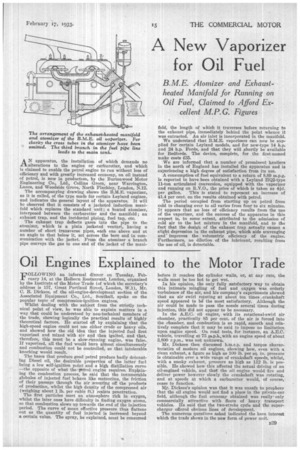Oil Engines Explained to the Motor Trade
Page 43

If you've noticed an error in this article please click here to report it so we can fix it.
"LI OLLOWING an informal dinner on Tuesday, Feb ruary 14, at the Holborn Restaurant, London, organized by the Institute of the Motor Trade (of which the secretary's address is 157, Great Portland Street, London, W.1), Mr. C. B. Dicksee, of the oil-engine-development section of the Associated Equipment Co., Ltd„ Southall, spoke on the popular topic of compression-ignition engines.
Whilst dealing with the subject from the strictly technical point of view, he was able to explain matters in a way that could be understood by non-technical members of the trade, showing logically the practical results of highly theoretical factors. He started off by explaining that the high-speed engine could not use either crude or heavy oils, and showed how the old idea that the injected fuel first vaporized and mixed with air and then ignited, and that, therefore, this must be a slow-running engine, was false. If vaporized, all the fuel would burn almost simultaneously and combustion could not be controlled, so that intolerable knocking would result.
The bases that produce good petrol produce badly detonating Diesel oil, the desirable properties of the latter fuel being a low self-ignition point and a high distillation curve —the opposite of what the pttrol engine requires. Explaining the combustion process, he said that the innumerable globules of injected fuel behave like meteorites, the friction of their passage through the air scouring off the products of production, whilst the high density of the compressed air (weighing about 1 lb. per cubic ft.) resists penetration. The first particles meet an atmosphere rich in oxygen, whilst the later ones have difficulty in finding oxygen atoms, so that combustion slows up towards the end of the injection period. The curve of mean effective pressure thus flattens out as the quantity of fuel injected is increased beyond a certain value. The spray, he explained, must be consumed before it reaches the cylinder walls, or, at any rate, the walls must be too hot to get wet.
In his opinion, the only fully satsfactory way to obtain this intimate mingling of fuel and oxygen was orderly turbulence of the air, and his company's experiments showed that an air swirl rotating at about ten times _crankshaft speed appeared to be the most satisfactory. Although the air could be made to pass the nozzle several times during injection, this did not appear to be necessary.
In the A.E.C. oil engine, with its rotational-swirl air chamber, practically 85 per cent. of the air is forced into the chamber, and combustion is so rapid, smooth and relatively complete that it may be said to impose no limitation upon engine speed. On road tests, for instance, an A.E.C. vehicle, travelling at 75 pa.p.h.,.with an engine speed of about 3,800 r.p.m., was not vinknown.
Mr. Dicksee then discussed b.m.e.p. and torque characteristics of modern oil engines, showing how, even with a clean exhaust, a figure as high as 100 lb. per sq. in. pressure is obtainable over a wide range of crankshaft speeds, whilst, with a smoky exhaust, pressure as high as 112 lb. is possible. He showed how this affected the actual driving of an oil-engined vehicle, and that the oil engine would fire and deliver power however slowly the crankshaft was rotating, and at speeds at which a carburetter would, of course, cease to function.
Dicksee's opinion was that it was unsafe to prophesy that the oil engine would not find a place in the private-car field, although the fuel economy obtained was reallyonly commercially attractive with fleets of heavy transport vehicles. He said that the two-stroke cycle and the supercharger offered obvious lines of development.
The numerous questions asked indicated the keen interest which the trade shows in the new form of power unit,




























































































